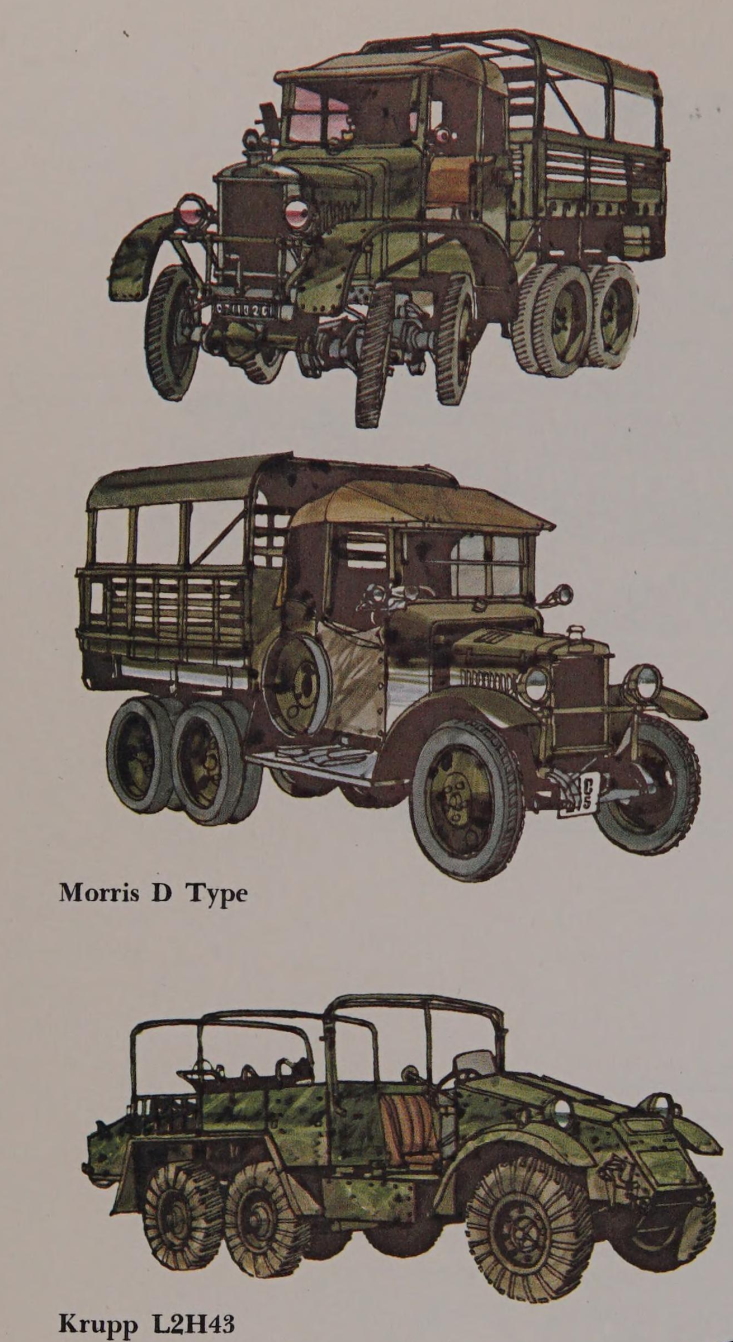
Big strides were made with the development of military motor transport between the wars. These article show a selection of typical vehicles developed over the period. One British experimental design is shown, the Armstrong-Saurer of 1929, which had twin steering front axles in an attempt to improve cross-country performance and handling. The standard German light truck of the 1930s was the Krupp L2H43, a 6 X 4 vehicle with a 52 hp air-cooled engine. It was used for several roles, notably as a troop transporter, a towing vehicle for light AA and anti-tank guns, as a decontamination vehicle, and as a maintenance vehicle. It was a very successful design, still in wide service during World War II. It had all-round independent suspension. In the late 1920s the British War Office issued new requirements for subsidy vehicles. One was for a light 1-to 1.5-ton 6 X 4 truck using a patent WD designed rear suspension which allowed both rear axles to be driven . A well-type body was specified so that personnel could sit each side Morris-Commercial produced their D type, to this specification and it was widely used, some being still in service in World War II. Other makers included Crossley, Vulcan, and Garner. In the late 1930s the light type lorry was replaced by the 15 cwt 4 X 2-type truck. This was sometimes called a ‘platoon truck’, as in the re-equipped mechanised British Army it was planned to allocate one to every infantry platoon, to carry personnel and equipment. The Morris Commercial 15 cwt CS8 was the first in production in 1935-36. These vehicles utilised as many commercial parts as possible but were simplified by the omission of a cab, which also facilitated fitting. Other major 15 cwt makers were Guy, Ford, Commer, and Bedford. Later vehicles had cabs and side doors.
In 1927 requirements for a six-wheeled 3-ton truck were put out by the British Army, based partly on the result of trials with a French Renault six-wheeler. The firm of Karrier had produced a rigid six-wheeler in 1925 which performed well on military trials. The Army designed a flexible rear bogie, similar to that on the Karrier, and this was patented and offered for use by firms who wished to produce trucks to meet the 1927 subsidy specifications. Most truck manufacturers in Britain built 3-tonners to meet these requirements, a Crossley searchlight carrier being shown. A version of the Morris ‘light’ 30 cwt 6 X 4.
The Morris-Commercial 6 X 4 30cwt chassis was used for a purpose-built gun tractor which hauled the 18-pdr field gun originally , but in World War II was to become a tractor for light AA guns. Mechanically this vehicle was similar to the Morris ‘D’ type, but it had the WD-type bonnet and fittings as on the 15-cwt truck . Below is shown a typical adaptation of a commercial vehicle. This Morris . Commercia bus was used as a mobile recruiting office in 1938 when the British Army started a major recruiting drive.
A Scammell Pioneer tows an 8-inch howitzer of 1st Heavy Regiment, near Calais
Mechanisation was carried out in a very thorough manner in the 1920s and 1930s, particular attention being given to the development of purpose built artillery tractors and the three major types in service by 1940 are shown. The Scammell Pioneer in its basic form, dates from 1927, though the World War II period model is shown here. This was an exceptionally fine, strong design, with an excellent suspension and diesel engine. The body had space for gun crew, stores, and ammunition, with an internal gantry and purchase for unloading ammunition. The Scammell was used as a towing vehicle for the 6-in Howitzer, 7.2-in gun, or the 3.7-in AA gun.
3.7-inch gun being towed by an AEC matador lorry through the ruins of Caen.
The AEC Matador was a fine vehicle which entered service in 1939, and was built in large numbers. It was used to tow medium artillery. The main task of the Matador was towing the 4.5/5.5-in fun and 3.7-in AA gun . The Matador had a 6 cylinder 95 hp engine.
Fully enclosed field-artillery tractor (FAT) towing a limber and 25-pdr
The field-artillery was radically re-equipped. The old 18-pdr was replaced in 1940 by the 25-pdr, with its limber, being towed by the new purpose-built, fully enclosed field-artillery tractor (FAT) which appeared in 1938. This type of vehicle was made by several firms, including Guy, Karrier and Morris-Commercial. The FAT was a four-wheel-drive type. Gun crew and stores were accommodated in the vehicle. Thousands of FATS were built and the shape became one of the most familiar of its time.